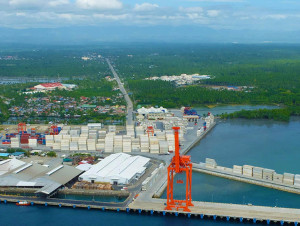
The Davao International Container Terminal (DICT) is allocating an estimated P1.8 billion to finance the second phase of its development in a move designed to adjust to growing container traffic at the Davao Del Norte port.
In an email to PortCalls, Bonifacio Licayan, assistant general manager of DICT port operator San Vicente Terminal and Brokerage Services, Inc. (SVTBSI), said the investments will go to constructing a second berth, and purchasing additional equipment including two quay cranes and five rubber-tired gantry (RTG) cranes to bring DICT’s equipment count to four quay cranes and eight RTGs.
The terminal will also acquire two more reach stackers, four empty container handlers, 14 yard goats, and 16 bomb carts to support operations.
“As part of our second phase, we are now also developing an additional 5-hectare off-dock empty container depot (ECD), which is about 30% complete by now,” Licayan added.
Together with DICT’s existing three-hectare ECD, the new container depot will bring eight hectares of space dedicated to handling empty containers “to include the attendant services of pre-trip inspection, washing, and maintenance and repair.”
“This is intended to de-clog the on-dock container yard by limiting the latter to handling laden containers, and repo-in and repo-out empties only,” Licayan explained.
DICT started operations in 2013 and the Anflocor Group, of which SVTBSI is a member, invested P2.7 billion in the project.
Brisk traffic at Davao Del Norte port
Container traffic at the Davao Del Norte port reached 134,083 twenty-foot equivalent units (TEUs) in the first half of 2015, or 61% higher than the 83,259 TEUs handled in the same period in 2014.
The port serviced 144 vessels from January to June this year, 84.6% more than the 78 ship calls last year.
Licayan said there are now six regular ship calls per week after CMA CGM brought in a new service, the China 2 service, in partnership with T.S. Lines.
Asked if vessels calling DICT are getting bigger, Licayan said, “Right now, the concern of the shipping lines is not the size of the vessel but the reduction in the volume of cargoes, especially bananas, which dipped due to the long drought in the previous months and now the lack of sunlight due to overcast skies.”
“However, some of the shipping lines have actually upgraded their fleet with bigger vessels with more reefer plugs,” Licayan noted.
This year, he said DICT will likely handle about 300,000 TEUs. During its pre-operating year in 2013, DICT handled 16,135 TEUs. When commercial operations began in January 2014, the volume shot up to 228,212 TEUs, or a whopping 1,414% growth.
“Definitely, it can be said that DICT has contributed to the growth in Davao Region by facilitating container trade, but at the same time (it) benefited from said growth as shown in the growing container volume handled,” Licayan said.
Asked if the growing volume can be handled by the road network to the port, Licayan said the Department of Public Works and Highways “has fully supported our port and other expansions in Panabo City by building a coastal road.”
“A four-lane 30-meter wide coastal road, the construction of which is already ongoing, will connect DICT to Davao City and the northern towns of Carmen, Dujali and the rest of Davao del Norte Province as well as, Compostela Valley and Davao Oriental Provinces,” he added.
The road will also allow trucks headed for DICT to bypass downtown Panabo City, contributing to a much improved traffic flow, Licayan pointed out.
Meanwhile, asked on how the planned development and modernization of Davao Sasa Port, currently a government port up for privatization, will affect DICT’s operations, Licayan replied, “Sasa will definitely have its share of cargoes especially those coming from or going to Davao City.”
“However, bananas, which is the premium cargo and the real driver for the economy of Davao Region, will continue to be shipped through DICT,” Licayan said.
He cited several reasons for this, one being that DICT is strategically located near the banana plantations, resulting in substantially lower transport costs compared to shipping bananas through Sasa Port.
Moreover, “DICT offers very efficient port operations that vessel stay becomes predictable and where the vessels arrive and depart right on schedule, thereby allowing export bananas to reach the global market right on time also,” he said.
The port executive said DICT, through its parent company TADECO and joint venture partner DOLE, also has its own sizeable internal volume of both bananas and pineapples.
“And because of our own internal volume, it allows us to have a huge share of the dry import volume composed of papers, plastics, fertilizers and other farm inputs that are required to support our own banana and pineapple operations,” Licayan explained. Banana and pineapple-related dry import volume accounts for about 35% of the total dry import of Davao, he said. – Roumina Pablo





